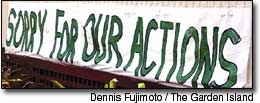Five students who admitted to painting graffiti on campus buildings won’t be walking with classmates at commencement exercises tomorrow at Kapa‘a High School. That’s despite apologies by the students and impassioned pleas from Kapa‘a High School Class of 2005 graduates
Five students who admitted to painting graffiti on campus buildings won’t be walking with classmates at commencement exercises tomorrow at Kapa‘a High School.
That’s despite apologies by the students and impassioned pleas from Kapa‘a High School Class of 2005 graduates and friends at school.
Attempts by parents to persuade Principal Gilmore Youn and state Department of Education Kaua‘i Superintendent Daniel Hamada to change their minds have also failed.
“It’s the worst case of desecration I’ve seen in my 35 years here,” said Youn. He made the call to keep the five male students out of commencement exercises.
Had Youn called police and had the boys arrested, they would have been suspended from school and received a police record that could haunt them the rest of their lives, on top of still not beening allowed to walk with classmates at graduation festivities, he said.
To show remorse, the boys apologized, both to Youn and to the entire school, put up posters at school stating they are sorry for their actions, and even painted new lines of parking stalls in the student parking lot, said Nani Saffer, a fellow senior who admitted to being on campus during at least one of the three days of vandalism.
She is being allowed to walk after Youn’s investigation revealed she didn’t participate in any of the painting.
Saffer has been working to persuade Youn to allow the five boys to walk in commencement festivities. One of the boys has family flying in from Tonga to witness the graduation activities, she said.
“Seeing these boys fight for their graduation rights has been devastating,” Saffer said. “Without your best friends at your side, graduation just doesn’t seem as special.”
Youn said he didn’t want to send a message that some people can get away with actions others as recently as last year were punished for. And the Kapa‘a principal isn’t budging.
Saffer said it has been something of a tradition, since 1998, for members of the senior class to paint the number of their graduating year atop one of the buildings on campus.
Youn sees the tradition as trespassing and vandalism, and as against the law and contrary to school rules.
To curtail and prevent future graffiti and vandalism incidents he has ordered the building of a fence to secure the campus during non-school hours, and he might install surveillance cameras.
The five students left their initials on the roof and in other places on campus, and admitted to their actions, he said.
One of those involved earlier this school year wrote an article in the school newspaper, Tradewind, decrying vandalism on campus, and then vandalized the campus, Youn said.
Saffer said parents called Hamada and met with Youn, offering to do just about anything if Youn would allow their sons to walk at graduation.
Several of the five are going to go to college on scholarships, and one of the boys experienced his first trip to the principal’s office ever on Monday, after the events of Friday, Saturday and Sunday when the vandalism occurred.
Some were caught by campus security officers on Sunday, Youn said.
Youn said the boys were bragging to fellow students and teachers about their actions, and only began to show remorse after he told them they wouldn’t be able to walk at graduation.
“I see the arrogance in this whole issue,” Youn said.
“I reviewed the cases because a number of the family members did contact me,” said Hamada, who stands behind Youn’s decision. The actions of the boys were “serious,” and “clearly a violation of school rules,” Hamada said. “Graffiti at the school is serious,” and the disciplinary action suited the infractions, he said.
- Paul C. Curtis, associate editor, may be reached at 245-3681 (ext. 224) or pcurtis@pulitzer.net.


